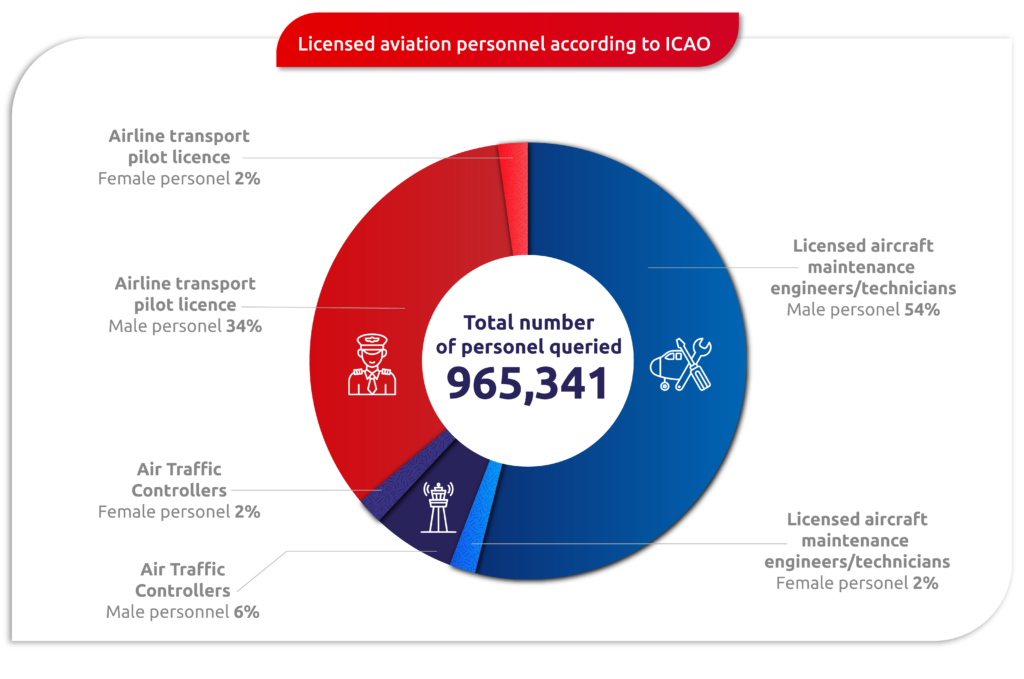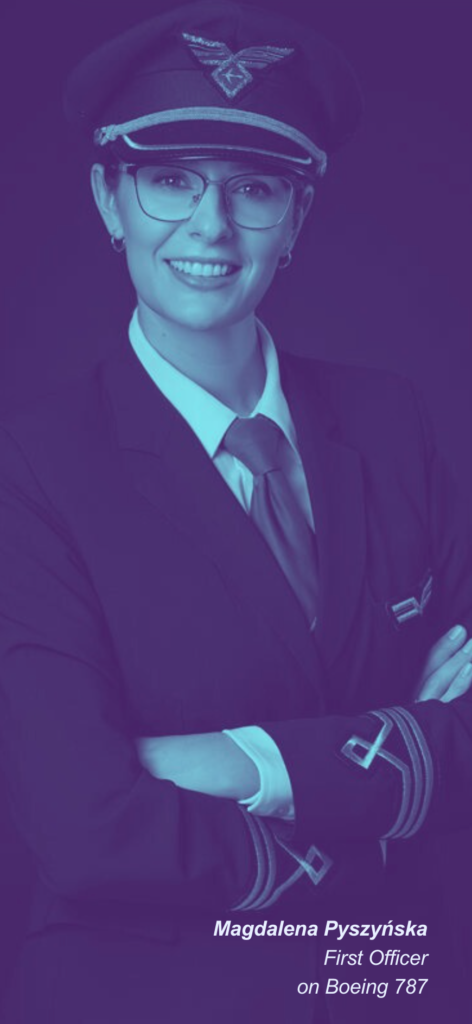


Archival photo: Amelia Earhart – The first woman to fly across the Atlantic Ocean as a passenger and the first woman to do so solo as a pilot, for which she was awarded the Distinguished Flying Cross.
The European Union, the International Labour Organization and a number of institutions worldwide are working towards gender equality.[1][2] Achieving gender equality in employment and equal pay for equal work promotes economic development and increases the standard of living. According to data provided by the World Economic Forum, the countries with the smallest gender gap are mostly those with the highest GDP per capita[3].
Aviation industry is highly diversified in terms of employment levels, depending on the type of work and/or job performed. Cabin crew are mostly female, while the vast majority of pilots and engineers are male – a common denominator throughout the industry worldwide.
According to the latest data from the International Civil Aviation Organization (ICAO)[4], the global share of licensed female flight personnel, including pilots, air traffic controllers and maintenance personnel, was ca. 5.13 percent. Women currently make up 4.69 percent of all pilots, 3.11 percent of aircraft maintenance engineers, but as many as 21.12 percent of air traffic controllers.

In Europe alone, these figures differ slightly: women make up 4.2 percent of pilots, 4.08 percent of engineers and 21.97 percent of air traffic controllers. The most feminised segment of aviation is air traffic control in Latin America, with women making up 34.45 percent of the employees.
In Poland, currently approximately 3.4 percent of licensed engineers are women – which accounts for an increase of 1.2 percent compared to 2020. Regarding the air traffic control service, women account for as many as 27 percent, which is 1.3 percent more than five years ago. As for pilots with an ATPL(A) licence, women make up 4 percent, which represents a 0.3 percent increase compared to 2020[1].
Regional diversification
A slightly different perspective on the number of female aviation professionals is provided by an IATA report based on data from 2023[1]. Women account for 41 percent of all employees in the aviation companies participating in the survey, which shows a progressive trend towards gender equality in the industry. However, it is worth noting that these figures include the total number of employees, including cabin crew and other unlicensed positions.
The least masculinised region in terms of women’s participation in the profession is Asia-Pacific, where they account for 47% of all employees. Europe is not as good, but above the global average. The fewest number of female aviation professionals is recorded in the Africa and Middle East region, where they make up 33% of the total number. This is due among other things to cultural and religious factors.
IATA data show that airports and manufacturing companies are mostly dominated by men, with a women’s share of 18.4 percent and 18.8 percent respectively. Airlines report the highest share of female employees (42.4 percent), which is due to the high proportion of female cabin crew members. Aircraft leasing industry is also dominated by women, as are air traffic management agencies and travel agencies.
Despite the relatively high representation of women among all airline employees, women are still underrepresented in cockpit roles. According to IATA data, an average of 6 percent of all cockpit crew in 2023 were women. Here, too, a significant regional difference can be observed: from 3.7 percent in Africa and the Middle East, to 7 percent in Europe, to 12.3 percent in North Asia.
Nevertheless, the number of female pilots is increasing rapidly. In the United States, for example, the percentage of female pilots increases to 8.2 percent in the lower age groups. The UK Civil Aviation Authority, in turn, reports that there has been a 26 percent increase in the number of pilot licences obtained by women between 2019 and 2023. A similar trend can be noticed in many countries around the world.
India ranks highest in terms of gender diversity in aviation, with women making up 14 percent of commercial pilots. It is a success story driven by a wide range of contributing factors, such as corporate equal opportunities schemes for women, government initiatives and, in some cases, a great deal of help from family members. India has also been encouraging women to study science, technology, engineering and mathematics (STEM), with very positive results.
According to the IATA report, women are already fairly well represented in management positions – 31 percent globally. Significantly, every region, with the marginal exception of North Asia (24 percent), reported that women occupy more than a quarter of management roles, with Europe performing best in this respect.
Rapid rise in female employment
Between 2021 and 2023, ca. 149,000 new employees were hired, of which almost 48 percent were women, which resulted in an increase of 1 percentage point in the share of women in total employment in the sector. Given the number of employees in the aviation industry, this is a significant result achieved in a relatively short period of time.
Over the specified period, 10,500 additional flight crew employees were hired, with women accounting for ca. 12 percent of the new hires. This is significantly higher than the 5.1 percent share of women performing cockpit roles witnessed in 2021. This has contributed to a 37 percent increase in the number of women in these positions, which indicates significant progress towards gender diversity among pilots. The rise was further fuelled by bigger and highly targeted investments in the industry with the objective of attracting women to the sector.
According to IATA, the most distinguished region was North Asia, which has more than doubled the share of female employees among flight crew members over the past two years. The percentage of women occupying technical positions increased in all regions, with the greatest increase (2.9 percentage points) observed in Europe.
Interestingly enough, the percentage of women employed as cabin crew has decreased by 0.3 percentage point. The slight decrease in the overall share of women is due to the fact that men are increasingly taking up jobs as flight attendants, and more and more airlines are committed to providing a better gender balance and hiring more men for this job.


Being a woman in aviation, and especially as an aircraft engineer, is both challenging and extremely rewarding. Today, we make up less than 3 percent of all aircraft engineers, but our share is growing steadily. For me, this job is all about challenges, and I love them. You have to be resilient, self-confident and ready for continuous development – but that’s what makes this job so great. When you do something you really love, sky is the limit.
.….….….….….….….….….…
Justyna Wardziak
aircraft engineer, LOTAMS

Equality is the cure
The aviation sector continues to develop and is expected to grow steadily in the long term. According to IATA forecasts, the number of passenger flights will reach approx. 8 billion per year in 2043, compared to 3.8 billion in 2023. This growth will develop at a slightly slower pace in the more mature air traffic markets in Europe and North America, at 2.3 and 2.7 percent per year respectively, as of 2023. Despite this, given the size of these markets, even relatively modest growth rates will result in 650 million more passenger flights per year in these two regions by the end of 2043.
Along with the expected market growth, more employees – in all aviation-related occupations – will be needed to meet the increased demand. Automation and artificial intelligence will change the face of many jobs, yet it will not be possible to meet the growing demand unless the proportion of women working in the sectoral tournaments increases.
The situation in the Polish Aviation Group does not differ significantly from the European average, or if it does, it stands out in a positive way. As regards LOT Polish Airlines, the share of female flight personnel (pilots) increased to 7 percent in 2024 from approx. 5 percent in 2019. Interestingly, data from the Polish Aviation Academy shows an increasing interest among women in obtaining a PPL(A) licence, which is often their first step in a professional career. Today, 18 percent of individuals starting training are women, as opposed to only 15 percent in 2020[1].
At LOT Polish Airlines, too, there has been an increase in the number of male cabin crew. Women still dominate this group, however, their share has decreased from 74 percent in 2019 to 70 percent in 2025.
At LS Airport Services, women make up approximately 30% of all employees in the company. However, in the area of passenger services, LSAS employs almost as many women as men.
Moreover, trends point to an increase in the number of women employed in technical and operational positions.
In 2024, the total number of women employed at LOTAMS was 232, including 39 in production positions, 105 in production support, and 88 in back-office roles.
At LS Technics, women make up 11% of the company’s workforce, with a total of 92 female employees. More than half of them work in the technical field, and 14 women hold the position of aircraft mechanic.


Aviation is still mainly associated with men, but women are bravely storming the cockpits. At LOT Polish Airlines, we already make up 7 percent of the crew, exceeding the global average of 4 percent. This is a positive trend that I hope will continue.
Even though a woman in the cockpit comes as a surprise to some passengers, their reactions are very positive, which proves that social awareness is evolving. I often hear that women at work are known for their self-control, patience and focus on procedures. Maybe, but I feel that piloting skills do not depend on gender, but on knowledge of procedures, competence and experience.
I encourage all women to follow their dreams of flying. At LOT Polish Airlines, we already have 60 women at the controls and I firmly believe there will be more of us. Aviation is passion, challenge and a dream come true – it’s worth fighting for!
[1]Gender equality strategy: https://commission.europa.eu/strategy-and-policy/policies/justice-and-fundamental-rights/gender-equality/gender-equality-strategy_pl
[2] Women in business and management: Building on the legacy of the Beijing Declaration: https://www.ilo.org/publications/women-business-and-management-building-legacy-beijing-declaration
[3] More in: Global Gender Gap Report: https://www.weforum.org/publications/global-gender-gap-report-2024/
[4] Data is available on the ICAO website: https://public.tableau.com/app/profile/icaodataanalytics/viz/RegionalPersonnelByGenderAnalysis/PersonnelbyGender.
[5]Source: Data from the Civil Aviation Authority, own calculations.
[6] Source: IATA data as in “Gender in Aviation Celebrating progress while looking to the future”, September 2024. The data include entities that are signatories (currently over 200 entities, of which approximately 80 per cent are airlines) of the IATA 25by2025 initiative and participated in the survey.
[7] Estimates based on the attendance lists of PPL(A) theoretical training participants sent to the Civil Aviation Authority in the period from 2020 to 2025. Source: PAA
